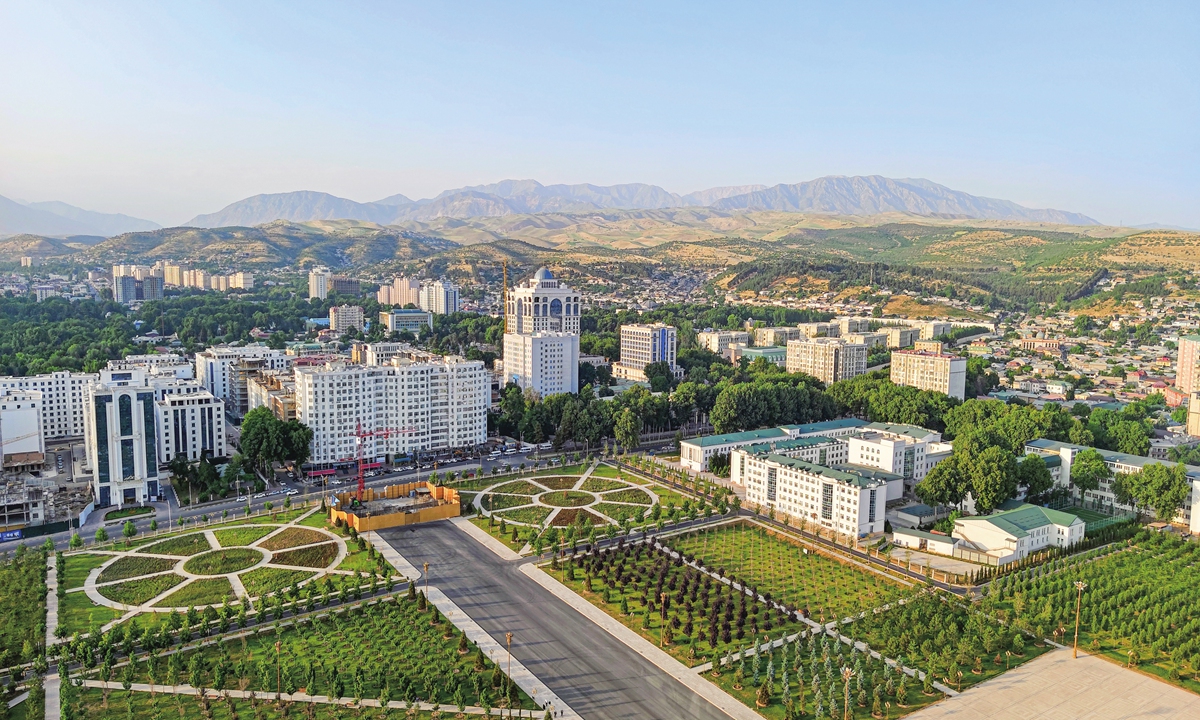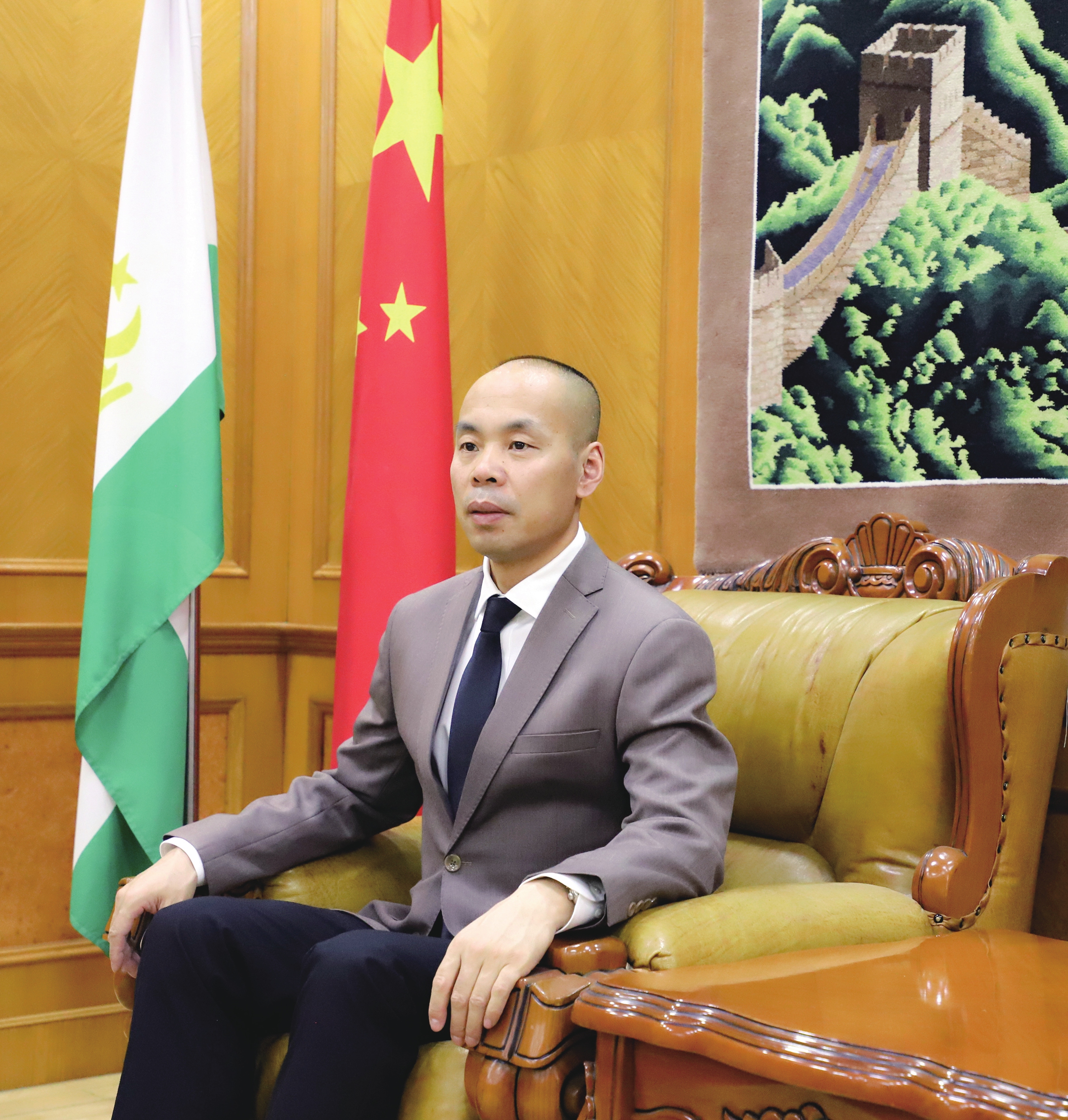
A city view of Dushanbe, capital of Tajikistan Photo: VCG
Editor's Note: Amid the 24th Meeting of the Council of Heads of State of the Shanghai Cooperation Organisation (SCO) in Astana, Kazakhstan, the Global Times reporters Li Xuanmin and Xing Xiaojing (
GT) conducted an interview with Ji Shumin
(Ji), Chinese Ambassador to Tajikistan. During the interview, Ji said that relations between the two countries have always maintained sound and stable development in the face of an ever-changing international situation. Bilateral relations have been consistently elevated to higher levels in the past decade. The future cooperation between the two countries has broad space and promising prospects. The two countries are committed to synergizing their development strategies under several multilateral cooperation frameworks.

Ji Shumin, Chinese Ambassador to Tajikistan Photo: Courtesy of Chinese Embassy in Tajikistan
GT: Both China and Tajikistan are founding members of the SCO. What kind of cooperation have China and Tajikistan engaged in under the SCO framework over the years? What role have the two countries played in the steady development of the organization?
Ji: China and Tajikistan, both founding members of the SCO, upholding the "Shanghai Spirit," which champions mutual trust, mutual benefit, equality, consultation, respect for diversity of civilizations and pursuit of common development.
Both China and Tajikistan are committed to promoting the building of an SCO community of common destiny and a China-Central Asia community of shared destiny. The two countries are committed to synergizing their development strategies with the China-proposed Belt and Road Initiative (BRI), advancing trade and investment liberalization and facilitation, and ensuring stable and unimpeded industrial and supply chains in the region.
China and Tajikistan have cooperated sincerely to disrupt terrorism, separatism and extremism, known as the "three evil forces," as well as drug trafficking, cybercrime and transnational organized crime, playing an important role in maintaining regional peace and stability and promoting common development and prosperity.
GT: As a diplomat who has been active in China-Tajikistan relations for many years, how do you view the current bilateral relations? How do you understand the profound meaning of the China-Tajikistan community of shared future?
Ji: Current China-Tajikistan relations are very close and set a good example of good-neighborliness, friendship and cooperation.
Speaking of Tajikistan and China-Tajikistan relations, some people may not be able to help but think of the Pamir Plateau, which closely connects the two countries, and the movie Visitors on the Icy Mountain (a black-white movie released in 1963 in China).
The two countries enjoyed a long history of exchanges, which dates back to the Western Han Dynasty (206BC-AD25) when the Silk Road (a series of trading and cultural transmission routes that started from China, through Central Asia, West Asia and linked the Mediterranean countries) was opened. Since then, the exchanges between the Chinese and Tajik peoples have become increasingly close.
Now, the relationship has been elevated to a level of mutual trust and mutual assistance. The two sides support each other on issues concerning their core interests, including national sovereignty, security and territorial integrity. Both China and Tajikistan are firmly opposed to politicizing, instrumenting and applying double standards to the human rights issues, and to any country interfering in other countries' internal affairs under the pretext of human rights.
Currently, China-Tajikistan relations are on the rise. Since the establishment of diplomatic ties between China and Tajikistan in 1992, bilateral relations have enjoyed sustained, sound and steady development.
Bilateral relations have entered a period of rapid development since 2012. In 2013, the two countries announced the establishment of a strategic partnership. In 2017, China-Tajikistan relations were upgraded to a comprehensive strategic partnership. In 2019, the two countries committed to building a community of shared development and security. In 2023, the two countries announced the building of a China-Tajikistan community with a shared future featuring everlasting friendship, solidarity and mutual benefit, setting a clear goal for the development of bilateral relations.
In the past decade, China-Tajikistan relations have been continuously boosted to higher levels. The momentum of development and progress of China-Tajikistan relations has remained unchanged.
China and Tajikistan have been leading the way in building a community with a shared future for mankind, of which the core concept is clear, that is: Friendship from generation to generation, sharing weal and woe, mutual benefit and win-win outcomes. China is willing to work together with Tajikistan to fully implement the consensus reached by the heads of state and bring more benefits to the two countries and their peoples.
GT: What have been some of the outcomes of China-Tajikistan cooperation under the BRI? What have been the demonstrative effects across Central Asia? Looking ahead, in what areas can China and Tajikistan deepen cooperation?
Ji: After China proposed the BRI in 2013, Tajikistan was one of the first countries to express support for and sign cooperation documents with China on jointly building the BRI, ushering in historic opportunities for cooperation.
According to statistics, the BRI has brought China-Tajikistan cooperation into a period of rapid growth. From 2013 to 2023, the trade volume between China and Tajikistan roughly doubled from $1.959 billion to $3.926 billion. China has become Tajikistan's largest source of investment and aid, and one of Tajikistan's most important trading partners.
From the perspective of industrial development, with the implementation of a series of China-Tajikistan cooperation and assistance projects within the framework of BRI , Tajikistan's infrastructure, energy, metallurgy, cement, cotton and other industrial sectors have achieved great progress, among which, cement and some other industries have changed Tajikistan from the original pure importer to an exporter.
The Zhongtai New Silk Road Agriculture and Textile Industrial Park in Tajikistan's Dangara Basin, founded by China's Zhongtai Group and Xinjiang Production and Construction Corp, has become the largest cotton textile industrial park in Central Asia.
From the perspective of social benefit, wholly-owned subsidiaries and joint ventures of Chinese enterprises in Tajikistan have created jobs for thousands of local people, become a major source of tax income for local government, and made important contributions to the sustainable economic and social development of Tajikistan.
At present, in addition to focusing on the four priority development directions of energy, transportation, food and industrialization, the Tajik government has also attached more and more attention to the digital economy and green development. China is actively promoting high-quality development by cultivating and developing new quality productive forces and high-quality cooperation in jointly building the BRI. In the future, the two countries will have more common language, more converging interests and growth points in their cooperation. Meanwhile, with the deepening of bilateral and multilateral cooperation under the China-Central Asia mechanism, BRI cooperation between China and the five Central Asian countries has shown a sound momentum of deep integration. This is particularly evident in the area of transport infrastructure connectivity, which is encouraging. High-level BRI cooperation is in line with the aspirations of the people and the trend of the times, which has broad space and promising prospects.
GT: At the end of 2022, the first Luban Workshop in Central Asia started operation in Tajikistan. How do you view the role of Luban Workshop in cultivating local technical talent? What is the impact on local economic development?
Ji: The establishment of the Luban Workshop in Tajikistan, the first one in Central Asia, is an important consensus reached by leaders of China and Tajikistan. The project was jointly established by the Tianjin Urban Construction Management and Vocation Technology College and Tajik Technical University. As a vital bridge for cultural exchanges and international cooperation in vocational education, the Luban Workshop is of great significance in promoting China-Tajikistan educational cooperation and serving bilateral cooperation in jointly building the BRI.
First, this is a pioneering project. Its construction and operation have broadened the field of educational cooperation between China and Central Asian countries and filled the gap in China-Central Asia cultural cooperation.
Second, this is a practical project. The Tajikistan Luban Workshop covers a construction area of 1,138 square meters, with urban thermal energy application technology and engineering surveying technology as two majors. It has built two teaching areas integrating theory and practice. It has built an online platform for courses and has been equipped with professional bilingual textbooks and practical training teaching equipment. The professional setting of the workshop is highly targeted to the priority goals of the economic and social development of Tajikistan and the main areas of China-Tajikistan cooperation in building the BRI.
In addition, this is an integrated project. The Luban Workshop in Tajikistan signed a strategic cooperation framework agreement with the Chamber of Commerce of Chinese Enterprises in Tajikistan. The workshop is working to train talent according to the needs of enterprises, while enterprises also take the initiative to communicate with the workshop about their employment needs, so that the talent training and needs can match.





